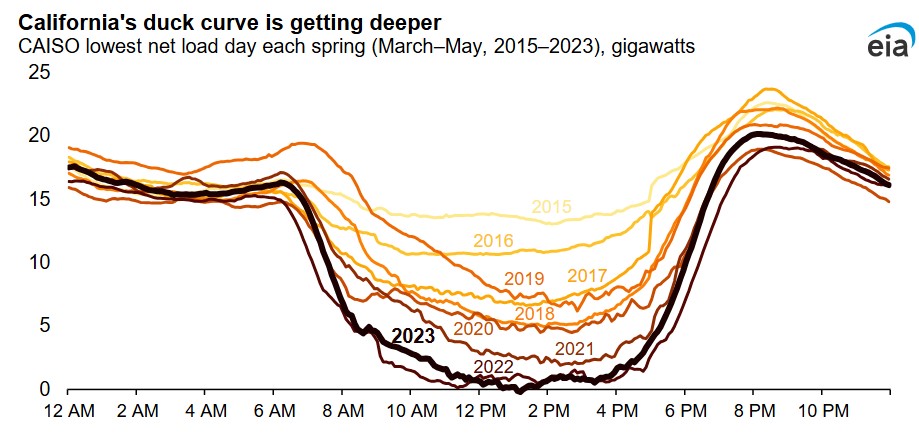Throwing Batteries at the Duck - How Energy Storage is Solving California’s Solar Problem

In August 1999, already infamous Philadelphia fans added another notch in their unruliness by throwing “large batteries” at a former Phillies player who had some contract disputes before leaving the city. The fans’ reaction caused widespread condemnation, with the opposing teams’ manager called for the Phillies to forfeit the game. The story is up there with throwing snowballs at Santa Clause in Philadelphia’s fans notorious disruptive behavior. Meanwhile on the opposite side of the country, batteries are disrupting norms again, this time as a positive solution.
Too Much Solar
California leads in installation of renewable energy, from the largest share of geothermal in the country, the first large wind farms, and the largest share of solar per capita. Renewable energy generates 54% of the state’s electricity. Recently, solar is ascendant in electricity generation, providing 28% of the state’s total electricity in 2028, second only to natural gas at 39%. The boom in solar power is not without its problems. Take for example load management. Most load follows a predictable pattern with two daily demand peaks: a peak in the morning as people wake up, and a larger peak in the afternoon and evening as people come home and turn on appliances. Thermal electricity generators, like coal, nuclear, and natural gas, can ramp up and down to meet these demands relatively easily. Solar throws a wrinkle in all this. During the day, solar energy on rooftops produces enough energy to drive demand down, while utility scale solar power plants drive down prices, both causing thermal power plants to ramp down or even stop production. In the evening, as solar winds down, the second daily peak starts to kick up fast and furious. To meet this spike, natural gas peaker plants, which are essentially giant jet essentially giant jet turbines, kick up in about 9 mins to meet the demand imbalance. This phenomenon described in the graph below, is called the duck curve.

Whether or not you see the duck, the graph has three major ramifications. First, because power plants must quickly ramp up, large stress is applied to the grid and operators may not be able to meet demand in time, leading to blackout risk. Second, because of the over production of solar during the day, operators often curtail the generation of solar to protect the grid, leaving the electricity produced nowhere to go. Third, the dynamics of the curve makes dispatchable thermal power plants less economical to run, leading to their shut down. While this may be a positive to the climate in the long run, the loss of dispatchable assets in the short-term leads to further grid stresses.
Here Comes the Batteries
However, all these above factors create a boon for batteries. They respond to grid demand in seconds, charge off the excess solar production, and profit from charging at low prices and discharging at high prices. Indeed, developers are rapidly building battery projects in response. Since 2019, the state went from 770 MW to 13291 MW of battery power in October 2024, with 3000 MW put online since April 2024. The geographical chart below shows the amount of new battery projects being delivered to the grid from the most recent EIA data in June 2023.
This has led to more batteries taking up the excess solar load and less natural gas generation during peak hours, illustrated by both graphs below.

Charging is trimming some of the fat off the belly of the duck. Natural gas generation has taken less of the demand spike in previous years as batteries replace its role, and is down overall throughout the day
Challenges with Batteries and the Future Ahead
However, the battery future has not been all rosy. On January 16th of this year, a large fire the Moss Landing Facility near Monterey, California caused over 1000 nearby residents to evacuate. The fire produced higher than unusual levels of heavy metals in soils around the plant. This has led to the town suing the plant operator, and a bill being discussed in the California Assembly that would severely curtail new battery development in the state. While the fire has caused major concerns, it has been pointed out in primary investigations that the batteries used an older lithium ion chemistry (nickel-manganese-cobalt, or NMC, that is more energy dense but more prone to thermal runaway and therefore fires) and did not space batteries apart far enough. Current facilities use a newer lithium ion chemistry (iron-phosphate, or LMP, which is less energy dense but not as prone to thermal runaway, as well as being sourced from cheaper materials) and also isolate their batteries further apart so fire do not spread. The California Public Utilities Commission issued an order requiring further safety standards and developed emergency response plans. Clean up is still expected to take years, and with batteries expected to play a large role in energy transition, robust safety precautions and community engagement on the risk of battery storage need to be addressed to have the public’s support for more projects. New battery technologies, such as iron-air batteries and sodium ion batteries, hope to tackle the safety problem by having less reactive chemistries, a better-established supply chain, lower cost, and in iron-air’s cases, longer storage durations. Both these technologies see pilot projects and expansions in the next few years, with breakthroughs to offer alternatives to the dominate lithium-ion chemistry. While addressing the safety aspects is a large concern, the application and promise of batteries is enormous, and the trends we see in California will likely play out in the rest of the US in the near future.